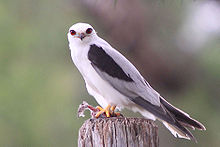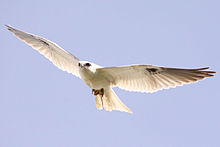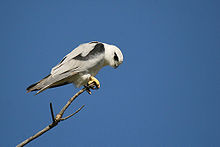Black-shouldered Kite
| Black-shouldered Kite | |
|---|---|
 | |
| At Sandy Hollow, Hunter Valley, NSW | |
| Conservation status | |
| Scientific classification | |
| Kingdom: | Animalia |
| Phylum: | Chordata |
| Class: | Aves |
| Order: | Accipitriformes |
| Family: | Accipitridae |
| Genus: | Elanus |
| Species: | E. axillaris |
| Binomial name | |
| Elanus axillaris (Latham, 1802) | |
The Black-shouldered Kite (Elanus axillaris) or Australian Black-shouldered Kite is a smallraptor found in open habitat throughout Australia and resembles similar species found in Eurasia and North America, which have in the past also been named as Black-shouldered Kites. Measuring 35–38 cm (13.8–15 in) in length with a wingspan of 80–95 cm (31.5–37.4 in), the adult Black-shouldered Kite is a small and graceful, predominantly pale grey and white, raptor with black shoulders and red eyes. Their primary call is a clear whistle, uttered in flight and while hovering.
Though reported across Australia, they are most common in the south-east and south-west corners of the mainland. Their preferred habitat is open grasslands with scattered trees and they are often seen hunting along roadsides. Like all the elanid kites, it is a specialist predator of rodents, which it hunts singly or in pairs by hovering in mid-air above open land.
Black-shouldered Kites form monogamous pairs, breeding between August and January. The birds engage in aerial courtship displays which involve high circling flight and ritualised feeding mid-air. Three or four eggs are laid and incubated for around thirty days. Chicks are fully fledged within five weeks of hatching and can hunt for mice within a week of leaving the nest. Juveniles disperse widely from the home territory.
Taxonomy
The Black-shouldered Kite was first described by English ornithologist John Latham in 1802, as Falco axillaris.Its specific name is derived from the Latin axilla "shoulder". The name "Black-shouldered Kite" was formerly used for a Eurasian and African species, Elanus caeruleus, and the Australian bird and the North American species, the White-tailed Kite Elanus leucurus, were treated as subspecies of this. The threeElanus species have comparable plumage patterns and sizes, however, they are now regarded as distinct, and the name Black-winged Kite is used for E. caeruleus. Modern references to the Black-shouldered Kite should therefore unambiguously mean the Australian species, E. axillaris. The Australian Black-shouldered Kite was formerly called E. notatus, but it was not clear that the name applied to this species alone.
In 1851 British zoologist Edward Blyth described Elaninae, the "smooth clawed kites" as a formal subfamily of Accipitridae. However they are also grouped in Accipitrinae, the broader subfamily of hawks and eagles described by French ornithologist Louis Jean Pierre Vieillot in 1816.
A taxonomic proposal based on DNA studies has recommended classifying Elanus kites as a separate family (Elanidae).A 2004 molecular study of cytochrome-b DNA sequences shows them to have split off from typical hawks and eagles at an earlier date than the Osprey, which has been classified in its own family.
Description
Appearance
Black-shouldered Kites are around 35 to 38 cm in length (13.8 to 15 in) and have a wingspan of between 80 and 95 cm (31.5 to 37.4 in) and an average weight of 291 grams (10.26 oz). Adults are a very pale grey with a white head and white underparts. The leading edge of the inner wing is black. When perched, this gives them their prominent black "shoulders". They have red eyes, with a black 'comma' that extends behind the eyes. They have a squared tail, and like all birds, a streamlined aerodynamic body. The bill is short with a sharp, hooked tip to the upper mandible. Their nostrils and the cere (skin at the base of the bill) are bright yellow and the bill is black. The legs and feet are also yellow, and the feet have three toes facing forwards and one toe facing backwards. The sexes are similar, with females only just larger than males, although they can be up to 15% heavier.
The juveniles’ markings follow a similar pattern to adult birds, but they are washed with a rusty brown on the head and upper breast, and the back and wings are mottled buff or brown with prominent white tips. The young birds’ eyes are brown.
The Black-shouldered Kite is very similar to the related raptor species, the Letter-winged Kite (E. scriptus) but has the black mark above and behind the eye, a white rather than grey crown, and shows all-white underparts in flight except for the black patch at the shoulder and dark wingtips.
Vocalizations
Black-shouldered Kites are generally silent, except in the breeding season when their calls, though weak, can be persistent. They primarily utter clear whistled 'chee, chee, chee' calls in flight and while hovering, or a hoarse wheezing 'skree-ah' when perched. The call has been confused with that of a Silver Gull. A short high whistle is the primary contact call between a pair, while a harsh scraping call is the most common call used by females and large young, and brooding females call to their young with a deep, soft, frog-like croak.
A variety of different calls have been recorded from captive birds, including harsh, harmonic, chatter and whistle vocalisations. Harsh calls were made when a bird was alarmed or agitated, whistle-type calls were emitted in general contexts, sometimes monotonously, and shorter duration 'chatter' calls were given when a bird sighted a human near the enclosure.
Distribution and habitat
Although reported from almost all parts of Australia, they are most common in the relatively fertile south-east and south-west corners of the mainland, and in south-east Queensland. They are rare in the deep desert and appear to be only accidental visitors to northern Tasmania and the Torres Strait islands. As the species has an extremely large range and the population is increasing, it has been listed as "Least Concern" on the IUCN Red List of Threatened species.Although they are rare vagrants on the islands of Bass Strait and in northern Tasmania, on the Australian mainland they vary from uncommon to common, appearing almost anywhere following rain or the movement of flood waters.In southwestern Australia, they are now one of the most commonly recorded raptors in the wheatbelt.
They are sedentary, or nomadic following food sources. Their numbers fluctuate during droughtand floods, and can be irruptive in response to sudden increases in mouse populations. The most distant banding recovery was from South Australia to eastern New South Wales, a distance of 1000 km (600 mi).
Although found in timbered country, they are mainly birds of the grasslands. They prefer open areas with scattered clumps of trees, including tree-lined watercourses through open country. In urban areas they are found on the edge of towns on wasteland or irregularly mown areas. They also hunt over coastal dunes and drier marshland, and farmland. Black-shouldered Kites are most often seen hunting over grassy roadside verges.
European occupation of Australia has, on the whole, benefited Black-shouldered Kites through land clearing and irrigation for agriculture and grain harvesting and storage practices which provide suitable conditions for much larger numbers of mice. According to raptor researcher Dr Stephen Debus, this species did not suffer from eggshell thinning during the period of DDT use in Australia, though he believes it is possible that secondary poisoning may occur from rodenticides used during mouse plagues or from pesticides used during locust plagues.Populations in areas with high sheep and rabbit numbers may decline, as these animals compact the soil and reduce the available habitat for mice.
Behaviour
Sociality
Black-shouldered Kites usually hunt singly or in pairs, though where food is plentiful they occur in small family groups and can be loosely gregarious at times of irruptions, with up to seventy birds reported feeding together during a mouse plague. They roost communally, like other Elanusspecies.
They are territorial when food is not abundant. The practise of "tail flicking" where, on landing, the tail is flicked up and lowered and the movement repeated persistently is thought to be a possible territorial display. Black-shouldered Kites have been observed in aerial combat at the margins of territories, locking talons in a behaviour described as "grappling".
Food and hunting
Black-shouldered Kites live almost exclusively on mice, and have become a specialist predator of house mice in Australia, often following outbreaks of mouse plagues in rural areas.They take other suitably sized creatures when available, including grasshoppers, rats, small reptiles, birds, and even (very rarely) rabbits, but mice and other mouse-sized mammals account for over 90% of their diet. Their influence on mouse populations is probably significant: adults take two or three mice a day each if they can, around a thousand mice a year.On one occasion a male was observed bringing no less than 14 mice to a nest of well-advanced fledglings within an hour.In another study, a female Kite was seen to struggle back to fledglings in the nest with a three-quarters grown rabbit, a heavy load for such a small bird.
Like other elanid kites, Black-shouldered Kites hunt by quartering grasslands for small creatures. This can be from a perch, but more often by hovering in mid-air. When hunting the kite hovers with its body hanging almost vertically, and its head into the wind.Unlike the Australian Kestrel, the Black-winged Kite shows no obvious sideways movement, even in a strong breeze. One study of a nesting pair noted that the male searched aerially for 82% of the search time.Typically, a kite will hover 10 to 12 metres (30–40 ft) above a particular spot, peering down intently, sometimes for only a few seconds, often for a minute or more, then glide swiftly to a new vantage point and hover again. When hunting from a perch, a dead tree is the preferred platform. Like other Elanus kites, The Black-shouldered Kite grips a vertical branch with a foot on either side, each one above the other and turned inwards, which enables them to maintain a secure footing on relatively small branches.Though hovering is the most common hunting method, the Kites have been observed searching the ground beneath a vantage point for periods of up to an hour.
When a mouse or other prey is spotted, he kite drops silently onto it, feet-first with wings raised high; sometimes in one long drop to ground level, more often in two or more stages, with hovering pauses at intermediate heights. Prey is seized in the talons and about 75% of attacks are successful.Prey can either be eaten in flight or carried back to a perch. Birds will have a favoured feeding perch, beneath which accumulate piles of pellets or castings.
They are diurnal, preferring to hunt during the day, particularly in the early morning and mid to late afternoon, and will occasionally hunt in pairs. Their hunting patterns, outside breeding periods and periods of abundant prey, have distinct crepuscular peaks, perhaps corresponding to mouse activity.
Flight
Black-shouldered Kites spiral into the wind like a Kestrel. They soar with v-shaped up-curved wings, the primaries slightly spread and the tail widely fanned. In level flight progress is rather indirect. Their flight pattern has been described as 'winnowing' with soft steady beats interspersed with long glides on angled wings. They can most often be seen hovering with wings curved and tail pointing down.
Breeding
Aerial courtship displays involve single and mutual high circling flight, and the male may fly around slowly with stiff exaggerated flaps, commonly known as butterfly-flight.Courting males dive at the female, feeding her in mid-flight. The female grabs food from the male's talons with hers while flipping upside-down. They may lock talons and tumble downwards in a ritualised version of grappling, but release just before landing. All courtship displays are accompanied by constant calling.
Black-shouldered Kites form monogamous pairs. The breeding season is usually August to January, but is responsive to mice populations,and some pairs breed twice in a good season. Both sexes are involved in building the nest, which is a large untidy shallow cup of sticks usually in the foliage near the top of trees, taking about two weeks to complete the nest-building. The flat nest is built of thin twigs and is around 28 to 38 cm (11 to 15 in) across when newly built, but growing to around 78 cm (30.7 in) across and 58 cm (22.8 in) deep after repeated use. The nest is lined with green leaves and felted fur, though linings of grass and cow dung have also been reported.It is generally located in the canopy of an isolated or exposed tree in open country, elevated 5 to 20 m (15–60 ft) or more above the ground. Black-shouldered Kites have been known to use old Australian Magpie, crow or raven nests.
Females perform most of the care of eggs and nestlings, though males take a minor share of incubation and brooding. The clutch consists of three to four dull white eggs of a tapered oval shape measuring 42 x 31 mm and with red-brown blotches that are often heavier around the larger end of the egg. The female incubates the eggs for 30 days and when the eggs hatch the chicks are helpless but have soft down covering their body. For the first two weeks or so the female broods the chicks constantly, both day and night. The female does no hunting at all for the first three weeks after hatching, but calls to the male from the nest, and he generally responds by bringing food. The female feeds the chicks with the mice brought back to the nest by the male, feeding them in tiny pieces for the first week or two, at which time the chicks are capable of swallowing a mouse whole. The nestling period lasts around 36 days, and the post-fledging period at least 36 days with parental feeding for at least 22 days. When the chicks are older both parents take it in turns to feed them. Black feathers start to appear along the chicks' wings when they are about a fortnight old, and they are fully fledged and are ready to fly in five weeks.Within a week of leaving the nest the young birds are capable of hunting for mice on their own.
Juveniles disperse widely, taking up territory that can be as far as 1,000 km (600 mi) from the nest site.







No comments:
Post a Comment